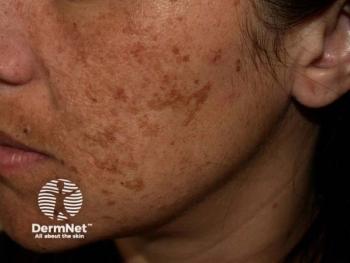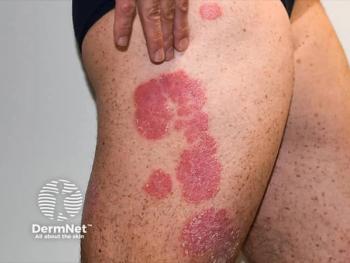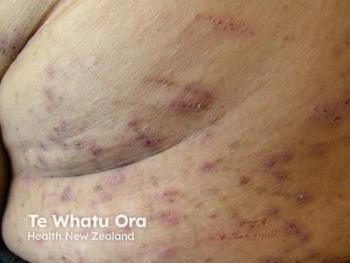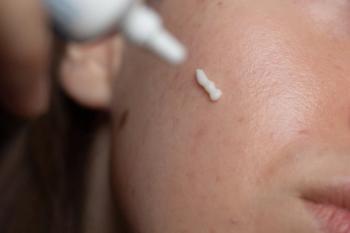
Cold Therapy May Relieve Inflammation in AD
Key Takeaways
- Whole-body cryotherapy (WBC) shows potential as a non-pharmacologic treatment for atopic dermatitis, offering anti-inflammatory and antipruritic benefits.
- WBC involves short-duration exposure to extremely cold temperatures, potentially improving antioxidative capacity and elevating anti-inflammatory cytokines.
Explore the potential of whole-body cryotherapy as a novel, nonpharmacologic treatment for effectively managing atopic dermatitis symptoms.
Atopic dermatitis (AD) remains one of the most common and burdensome chronic inflammatory skin diseases, affecting up to 10% of the population worldwide. Despite the availability of numerous treatment options—including topical anti-inflammatories, systemic agents, and targeted biologics—many patients continue to experience poorly controlled symptoms such as pruritus, erythema, and sleep disturbances.1 In recently published insights, Park et al explored the therapeutic potential of whole-body cryotherapy (WBC) as an emerging nonpharmacologic treatment strategy for AD, citing promising anti-inflammatory and antipruritic effects.2
According to Park et al, limited treatment efficacy in some patients has led researchers to investigate adjunctive or alternative approaches for symptom management.3 Cryotherapy, commonly used in dermatology for localized treatments, is increasingly being studied for its systemic immunomodulatory properties. In the context of AD, skin cooling is thought to exert anti-inflammatory effects by decreasing peripheral nerve conduction velocity, reducing acetylcholine synthesis, and downregulating inflammatory cytokines such as IL-4 and IL-5—factors closely associated with AD pathophysiology. Notably, Piao et al demonstrated that cold thermal therapy significantly reduced these cytokines in experimental settings.4
"While it might seem bizarre or even dangerous, whole-body cryotherapy is actually more established than some may realize,” study author Peter Lio, MD, told Dermatology Times. “Recently, I was thinking about the late great Lloyd E. King Jr, [MD, PhD], who used to talk about how cooling the skin is often used to decrease inflammation and swelling, and that it could perhaps be used for some of our chronic inflammatory disorders as well. Once you think about it that way, it makes sense that cooling the skin down could help with inflammation and itch in AD."
Park et al further discussed the distinction between localized cryotherapy and WBC, noting that although localized application has shown some benefit in reducing pruritus, WBC may offer broader systemic effects. WBC involves exposing the entire body to extremely cold temperatures (between –100 °C and –180 °C) for a short duration, typically under 3 minutes, within a cryochamber. The exposure is believed to increase antioxidative capacity and elevate systemic concentrations of anti-inflammatory cytokines, potentially leading to symptom improvement.2
Only 2 clinical studies to date have directly investigated the effects of WBC in patients with AD, both of which are referenced by Park et al. In a 2008 study by Klimenko et al, 18 patients with mild to moderate AD received WBC treatments 3 times weekly over 4 weeks without concurrent use of corticosteroids, calcineurin inhibitors, or antihistamines. Participants experienced significant improvements in SCORing Atopic Dermatitis (SCORAD) scores, pruritus, sleep quality, and transepidermal water loss (all P < .05). Adverse events were minimal, and patient satisfaction was high.2
A more recent 2020 study by Kepinska-Szyszkowska et al involved 14 patients with AD who were treated with 15 WBC sessions over 1 month. Like the earlier study, topical and systemic anti-inflammatories were withheld. Posttreatment assessments revealed a statistically significant reduction in SCORAD scores (P = .011) and transepidermal water loss (P < .05), with improvements sustained up to 3 weeks after the final session.5
Park et al emphasized the safety profile of WBC, noting that reported adverse events were limited to mild, transient effects such as dry skin and acral frostbite. They recommend that cryotherapy chambers include real-time monitoring, emergency stop mechanisms, and communication systems to ensure patient safety throughout treatment sessions.
Although early findings are promising, Park et al acknowledged key limitations in the current evidence base—including small study populations, lack of control groups, and limited follow-up—which restrict the ability to assess long-term outcomes or compare WBC with standard therapies. They conclude that WBC may represent a viable adjunctive therapy for patients with mild to moderate AD, particularly those seeking nonpharmacologic options or those with partial responses to existing treatments.
Further research, ideally in the form of large-scale randomized controlled trials, is needed to validate the efficacy and safety of WBC in AD and determine its optimal role in clinical practice. Until then, Park et al advised that WBC be approached as an experimental yet potentially valuable tool in the multidisciplinary management of AD.
References
- Eczema stats. National Eczema Association. 2024. Accessed July 2, 2025.
https://nationaleczema.org/research/eczema-facts/ - Klimenko T, Ahvenainen S, Karvonen SL. Whole-body cryotherapy in atopic dermatitis. Arch Dermatol. 2008;144(6):806-808. doi:10.1001/archderm.144.6.806
- Park A, Wan L, Lio P. Systemic cryotherapy: a potential therapeutic option for mild to moderate atopic dermatitis. J Clin Aesthet Dermatol. 2025;18(6):6-7.
- Piao CH, Kim M, Bui TT, et al. Anti-inflammatory effects of cold thermal therapy on allergic skin inflammation induced by trimellitic anhydride in BALB/c mice. Mediators Inflamm. 2019;2019:1936769. doi:10.1155/2019/1936769
- Kepinska-Szyszkowska M, Misiorek A, Kapinska-Mrowiecka M, Tabak J, Malina K. Assessment of the influence systemic cryotherapy exerts on chosen skin scores of patients with atopic dermatitis: pilot study. Biomed Res Int. 2020;2020:5279642. doi:10.1155/2020/5279642
Newsletter
Like what you’re reading? Subscribe to Dermatology Times for weekly updates on therapies, innovations, and real-world practice tips.


















